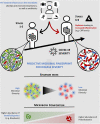Gut Microbiota Diversity and C-Reactive Protein Are Predictors of Disease Severity in COVID-19 Patients
- PMID: 34349747
- PMCID: PMC8326578
- DOI: 10.3389/fmicb.2021.705020
Gut Microbiota Diversity and C-Reactive Protein Are Predictors of Disease Severity in COVID-19 Patients
Abstract
The risk factors for coronavirus disease 2019 (COVID-19) severity are still poorly understood. Considering the pivotal role of the gut microbiota on host immune and inflammatory functions, we investigated the association between changes in the gut microbiota composition and the clinical severity of COVID-19. We conducted a multicenter cross-sectional study prospectively enrolling 115 COVID-19 patients categorized according to: (1) the WHO Clinical Progression Scale-mild, 19 (16.5%); moderate, 37 (32.2%); or severe, 59 (51.3%), and (2) the location of recovery from COVID-19-ambulatory, 14 (household isolation, 12.2%); hospitalized in ward, 40 (34.8%); or hospitalized in the intensive care unit, 61 (53.0%). Gut microbiota analysis was performed through 16S rRNA gene sequencing, and the data obtained were further related to the clinical parameters of COVID-19 patients. The risk factors for COVID-19 severity were identified by univariate and multivariable logistic regression models. In comparison to mild COVID-19 patients, the gut microbiota of moderate and severe patients have: (a) lower Firmicutes/Bacteroidetes ratio; (b) higher abundance of Proteobacteria; and (c) lower abundance of beneficial butyrate-producing bacteria such as the genera Roseburia and Lachnospira. Multivariable regression analysis showed that the Shannon diversity index [odds ratio (OR) = 2.85, 95% CI = 1.09-7.41, p = 0.032) and C-reactive protein (OR = 3.45, 95% CI = 1.33-8.91, p = 0.011) are risk factors for severe COVID-19 (a score of 6 or higher in the WHO Clinical Progression Scale). In conclusion, our results demonstrated that hospitalized patients with moderate and severe COVID-19 have microbial signatures of gut dysbiosis; for the first time, the gut microbiota diversity is pointed out as a prognostic biomarker of COVID-19 severity.
Keywords: COVID-19; Shannon—Weiner diversity index; WHO Clinical Progression Scale; dysbiosis; gut microbiota.
Copyright © 2021 Moreira-Rosário, Marques, Pinheiro, Araújo, Ribeiro, Rocha, Mota, Pestana, Ribeiro, Pereira, de Sousa, Pereira-Leal, de Sousa, Morais, Teixeira, Rocha, Silvestre, Príncipe, Gatta, Amado, Santos, Maltez, Boquinhas, de Sousa, Germano, Sarmento, Granja, Póvoa, Faria and Calhau.
Conflict of interest statement
The authors declare that the research was conducted in the absence of any commercial or financial relationships that could be construed as a potential conflict of interest.
Figures




Similar articles
-
Gut microbiota composition during hospitalization is associated with 60-day mortality after severe COVID-19.Crit Care. 2023 Feb 23;27(1):69. doi: 10.1186/s13054-023-04356-2. Crit Care. 2023. PMID: 36814280 Free PMC article.
-
[Analysis of the dynamic changes in gut microbiota in patients with extremely severe burns by 16S ribosomal RNA high-throughput sequencing technology].Zhonghua Shao Shang Za Zhi. 2020 Dec 20;36(12):1159-1166. doi: 10.3760/cma.j.cn501120-20200518-00271. Zhonghua Shao Shang Za Zhi. 2020. PMID: 33379852 Chinese.
-
The Gut Microbiota of Healthy Chilean Subjects Reveals a High Abundance of the Phylum Verrucomicrobia.Front Microbiol. 2017 Jun 30;8:1221. doi: 10.3389/fmicb.2017.01221. eCollection 2017. Front Microbiol. 2017. PMID: 28713349 Free PMC article.
-
Gallstone Disease, Obesity and the Firmicutes/Bacteroidetes Ratio as a Possible Biomarker of Gut Dysbiosis.J Pers Med. 2020 Dec 25;11(1):13. doi: 10.3390/jpm11010013. J Pers Med. 2020. PMID: 33375615 Free PMC article. Review.
-
Role of Gut Dysbiosis in Liver Diseases: What Have We Learned So Far?Diseases. 2019 Nov 12;7(4):58. doi: 10.3390/diseases7040058. Diseases. 2019. PMID: 31726747 Free PMC article. Review.
Cited by
-
Probiotics in the Management of Mental and Gastrointestinal Post-COVID Symptomes.J Clin Med. 2022 Aug 31;11(17):5155. doi: 10.3390/jcm11175155. J Clin Med. 2022. PMID: 36079082 Free PMC article. Review.
-
Importance of gut microbiome regulation for the prevention and recovery process after SARS-CoV-2 respiratory viral infection (Review).Biomed Rep. 2022 Apr;16(4):25. doi: 10.3892/br.2022.1508. Epub 2022 Feb 14. Biomed Rep. 2022. PMID: 35251612 Free PMC article. Review.
-
Microbial Signatures in COVID-19: Distinguishing Mild and Severe Disease via Gut Microbiota.Biomedicines. 2024 May 1;12(5):996. doi: 10.3390/biomedicines12050996. Biomedicines. 2024. PMID: 38790958 Free PMC article.
-
Explore the changes of intestinal flora in patients with coronavirus disease 2019 based on bioinformatics.Front Cell Infect Microbiol. 2023 Oct 13;13:1265028. doi: 10.3389/fcimb.2023.1265028. eCollection 2023. Front Cell Infect Microbiol. 2023. PMID: 37900316 Free PMC article.
-
Intestinal Alkaline Phosphatase Activity and Efficiency Are Altered in Severe COVID-19 Patients.Gastro Hep Adv. 2023 Jul 17;2(7):911-917. doi: 10.1016/j.gastha.2023.07.003. eCollection 2023. Gastro Hep Adv. 2023. PMID: 39130768 Free PMC article.
References
LinkOut - more resources
Full Text Sources
Research Materials

